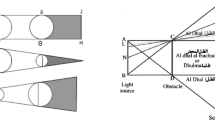Abstract
This article reports on the third year of a three-year longitudinal investigation into six secondary students' understanding of optics at a secondary school level. In the third year of this investigation the students, who by now were in Year 12, underwent a teaching sequence that centred on the teaching and learning of physical optics and quantum ideas. The students' mental models of the nature of light were explored prior to, and following this teaching sequence. The researcher took on the dual roles of teacher and researcher. This paper will outline the findings of the third year of this study and the implications they have for the teaching and learning of optics at secondary school level.
Similar content being viewed by others
References
Ambrose, B. S., Shaffer, P. S., Steinberg, R. N., & McDermott, L. C. (1999). An investigation of students' understanding of single-slit diffraction and double-slit interference. American Journal of Physics, 67(2), 146–155.
Board of Studies (1994). Physics VCE study design. Carlton, Victoria: Board of Studies.
Chi, M. T. H. (1992). Conceptual change within and across ontological categories: Examples from learning and discovery in science. In R. N. Giere (Ed.), Cognitive models of science (pp. 129–186). MN: University of Minnesota Press.
de Jong, E., Armitage, F., Brown, M., Butler, P., & Hayes, J. (1991). Physics two. Port Melbourne, Victoria: Rigby Heinemann.
Driver, R. (1995). Constructivist approaches to science teaching. In L. P. Steffe & J. Gale (Eds.), Constructivism in education (pp. 385–400). Hillsdale, New Jersey: Lawrence Erlbaum.
Driver, R., Asoko, H., Leach, J., Mortimer, E., & Scott, P. (1994). Constructing scientific knowledge in the classroom. Educational Researcher, 23(7), 5–12.
Feynman, R. P. (1985). QED: The strange theory of light and matter. Princeton, New Jersey: Princeton University Press.
Frisch, O. R. (1972). The nature of matter. London: Thames and Hudson.
Galili, I., Bendall, S., & Goldberg, F. (1993). The effects of prior knowledge and instruction on understanding image formation. Journal of Research in Science Teaching, 30(3), 271–301.
Galili, I., & Lavrik, V. (1998). Flux concept in learning about light: a critique of the present situation. Science Education, 82, 591–613.
Gilbert, J. K. (Ed.) (1994). Models and modelling in science education. Hatfield: The Association for Science Education.
Gilbert, J. K. (1995). Studies and fields: directions of research in science education. Studies in Science Education, 25(2), 173–197.
Gilbert, J. K., & Boulter, C. (1995, April). The role of models and modelling in some narratives of science learning. Paper presented at the Annual Conference of the American Educational Research Association, San Francisco.
Goldin, G. A. (1990). Epistemology, constructivism, and discovery learning mathematics. In R. B. Davies, C. A. Maher, & N. Noddings (Eds.), Constructivist views on the teaching and learning of mathematics (Monograph 4, pp. 31–50). Reston, Virginia: National Council of Teachers of Mathematics.
Grosslight, L., Unger, C., Jay, E., & Smith, C. (1991). Understanding models and their use in science: conceptions of middle and high school students and experts. Journal of Research in Science Teaching, 28(9), 799–822.
Guba, E. G., & Lincoln, Y. S. (1991). What is the constructivist paradigm? In D. S. Anderson & B. J. Biddle (Eds.), Knowledge for policy improving education through research (pp.158–170). London: Falmer.
Halloum, I. (1996). Schematic modelling for meaningful learning of physics. International Journal of Science Education, 33(9), 1019–1041.
Johnson-Laird, P. N. (1983). Mental models towards a cognitive science of language, inference, and consciousness. Cambridge: Cambridge University Press.
Johnston, I. D., Crawford, K., & Fletcher, P. R. (1988). Student difficulties in learning quantum mechanics. International Journal of Science Education, 20(4), 427–446.
Justi, R., & Gilbert, J. (2000). History and philosophy of science through models: Some challenges in the case of ‘the atom.’ International Journal of Science Education, 22(9), 993–1009.
Marburger, J. H. (1996). What is a photon? The Physics Teacher, 34, 482–486.
Munn, A. M. (1973). From nought to relativity – Creating the physical world model. London: George Allen & Unwin.
Nadeau, R., & Desautels, J. (1984). Epistemology and the teaching of science. Ottawa: Science Council of Canada.
Norman, D. A. (1983). Some observations on mental models. In D. Gentner & A. Stevens (Eds.), Mental models (pp. 7–14). Hillsdale, New Jersey: Lawrence Erlbaum.
Ohanian, H. C. (1985). Physics. New York: W. W. Norton.
Posner, G. L., Strike, K. A., Hewson, P. W., & Gertzog, W. A. (1982). Accommodation of a scientific conception: toward a theory of conceptual change. Science Education, 66(2), 211–227.
Ronchi, V. (1970). The nature of light. London: Heinemann.
Slotta, J. D., Chi, M. T. H., & Joram, E. (1995). Assessing students' misclassifications of physics concepts: an ontological basis for conceptual change. Cognition and Instruction, 13(3), 373–400.
Smit, F. F. A., & Finegold, M. (1995). Models in physics: perceptions held by final-year prospective physical science teachers studying at South African universities. International Journal of Science Education, 17(5), 621–634.
Steinberg, R. N., Oberem, G. E., & McDermott, L. C. (1996). Development of a computer-based tutorial on the photoelectric effect. American Journal of Physics, 64(11), 1370–1379.
Steinberg, R., Wittman, L. B., Bao, L., & Redish, E. F. (1999, March). The influence of student understanding of classical physics when learning quantum mechanics. Paper presented at the annual meeting National Association for Research in Science Teaching.
Vosniadou, S. (1994). Capturing and modelling the process of conceptual change. Learning and Instruction, 4(1), 45–69.
Author information
Authors and Affiliations
Corresponding author
Rights and permissions
About this article
Cite this article
Hubber, P. Year 12 Students' Mental Models of the Nature of Light. Res Sci Educ 36, 419–439 (2006). https://doi.org/10.1007/s11165-006-9013-x
Received:
Accepted:
Published:
Issue Date:
DOI: https://doi.org/10.1007/s11165-006-9013-x




